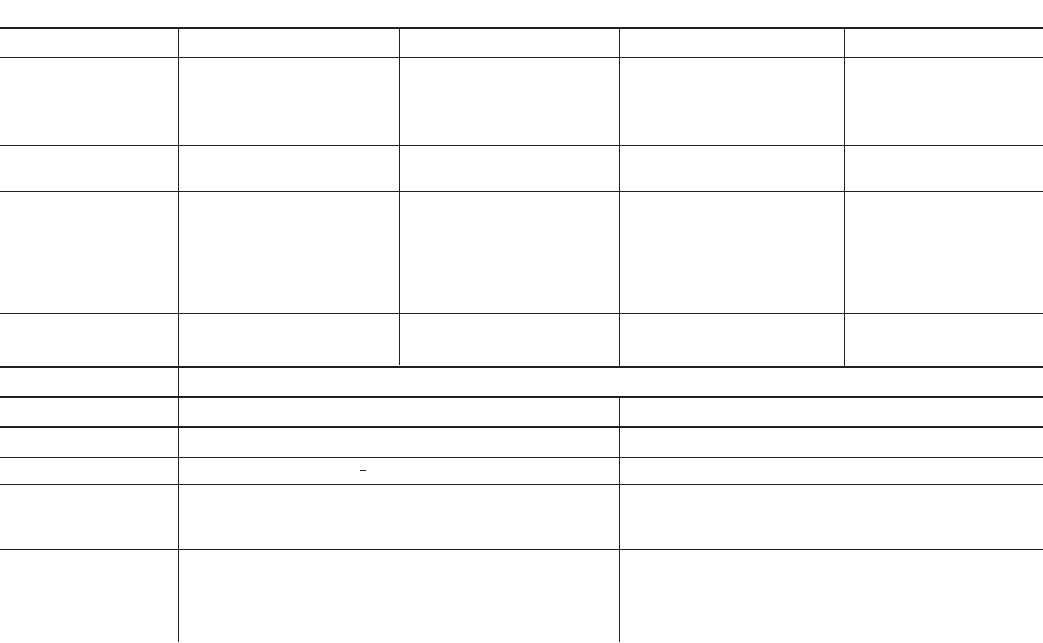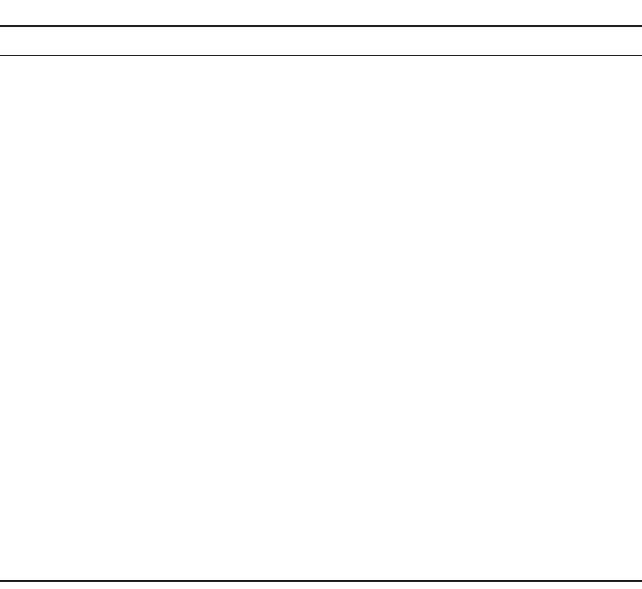Pump Handbook by Igor J. Karassik, Joseph P. Messina, Paul Cooper, Charles C. Heald - 3rd edition
Подождите немного. Документ загружается.


6.157
TABLE 1 Continued.
Straight-bevel gearing Spiral-bevel gearing Zerol-bevel gearing Hypoid gearing
Speed range pitch line Same as spur gearing Commercial, normal: up to Up to 15,000 (4500) for 6,000 (1800) to 10,000
velocity, ft/min 5,000 (1500); special ground gears (3000), depending on
(m/min) precision; up to 15,000 offset
(4500)
Gear efficiency, % Same as spur gearing 96 to 98 (commercial) 94 to 98 85 to 98, depending on
offset
Quietness of operation Same as spur gearing Noise level depends on Quieter than straight-bevel Quiet
quality of gear. Higher gears
pitch line velocity
—
above
5,000 ft/min (1500 m/min)
—
requires higher
precision gear.
Load imposed on Radial and thrust Radial and thrust Radial and thrust Radial and thrust
bearings
Worm gearing
Cylindrical Double-enveloping cone-drive gears
Shaft arrangement Nonintersecting, nonparallel axis Right angle in single-reduction units
Ratio range 3 :1 to 100:1 5:1 to 70:1
Size availability 300-in (762-cm) OD, 4-in (10.2-cm) circular pitch 2- to 24-in (5.1- to 61-cm) center distance. For special
(including maximum requirements, larger and smaller sizes are available.
face widths)
Gear tolerances (quality Worm gear tolerances given in AGMA Standard: Standard AGMA commercial tolerances. Closer
requirements) Inspection of Course-Pitch Cylindrical Works and Worm tolerances available for special applications
Gears, Standard No. 234.01
1
2

6.158
TABLE 1 Continued.
Worm gearing
Cylindrical Double-enveloping cone-drive gears
Finishing methods Worm gears: hobbed, worm-milled, and ground Worms: threads generated with cutter and finished by
(singly or in polishing. Gears: hobbed. Both members then lapped
combination) and matched together
Power range, hp (kW) Up to 400 (300) Fractional to 1,430 (1070) dependent on ratio, center
distance, and speed
Speed range pitch line Up to 6000 (1830) 0 to 2400 rpm, or 2000 (610) rubbing speed with splash
velocity, ft/min (m/min) lubrication. Higher speeds permissible with special
combinations.
Gear efficiency, % From 25 to 95, depending on ratio 52 to 94, depending on ratio and speed
Quietness of operation Relatively quiet operation up to 6000 ft/min (1830 m/min) Smooth and quiet up to 2000 ft/min (610 m/min); can
run quietly at higher speeds with special attention to
lubrication, mounting, materials, balancing, and so on.
Load imposed on Radial and thrust Radial and thrust
bearings
Gear tolerances are dependent on method of manufacture, application, load requirements, and speeds. For spur, helical, and herringbone gears, ANSI/AGMA
Gear Classification Manual 2000 A-88 lists quality numbers from 3 to 15 for coarse-pitch gears and 5 to 16 for fine-pitch gears, quality increasing as quality num-
ber increases. The general range of quality for gears now being manufactured is from quality numbers 5 to 14. Quality numbers relate to runout, tooth-to-tooth,
spacing, profile, total composite, and lead tolerances. Bevel and hypoid gear tolerances range from 3 to 13.

6.2.4 GEARS 6.159
FIGURE 8 Single epicyclic gear drives
unit is transmitting its rated power because when no power is being transmitted through
the reducer, all the input power (small as it may be) is used in friction and the efficiency
is zero.
Ratios available in standard reducers and efficiencies to be expected when units are
transmitting rated power are given in Table 1.
Epicyclic Gear Units Epicyclic gear units are sometimes used for pump drive applica-
tions. The important advantages are compact configuration, coaxial shafts, and light
weight.
The most common types of epicyclic arrangements are planetary, star, and solar (Fig-
ure 8). The planetary configuration (with the planet carriers integral with the output
shaft) is the most commonly used arrangement. It is simple and rugged and gives the max-
imum ratio for the size of gears. The star arrangement (where the planet carrier is fixed
and the internal gear rotates integrally with the output shaft) is used for higher-speed
applications because centrifugal loads of the planet gears are eliminated with nonrotating
planet carrier. The solar arrangement (where the pinion is fixed and the planet carrier is
integral with the output shaft) has the input through the internal gear. This arrangement
gives epicyclic advantages but allows a low ratio, generally less than 2:1. Higher ratios (in
the range of 8:1 to 60:1) can be obtained utilizing double-reduction or compound-planetary
arrangements.
INSTALLATION_______________________________________________________
The basic gear unit is generally shipped from the factory completely assembled. Mating
gears and pinions are carefully assembled at the factory to provide proper tooth contact.
Nothing should be done to disturb this setting.
6.160 CHAPTER SIX
Solid Foundation The reducer foundation should be rigid enough to maintain correct
alignment with connected machinery. The foundation should have a flat mounting sur-
face in order to assure uniform support for the unit. If the unit is mounted on a surface
other than horizontal, consult the factory to ensure that the design provides for proper
tooth contact and adequate lubrication.
The design of fabricated pedestals or baseplates for mounting speed reducers should be
carefully analyzed to determine that they are sufficiently rigid to withstand operating
vibrations. Vibration dampening materials may be used under the baseplate to minimize
the effect of vibrations.
When mounting a drive on structural steel, the use of a rigid baseplate is strongly rec-
ommended. Bolt unit and baseplate securely to steel supports with proper shimming to
ensure a level surface.
If a drive is mounted on a concrete foundation, allow the concrete to set firmly before
bolting down the unit. For the best mounting, grout structural steel mounting pads into
the concrete base rather than grouting the gear unit directly into the concrete.
The gear unit inspection covers should be removed and a tooth contact check be per-
formed using a color transfer material to ensure that the contact in the field is the same
as when checked in the manufacturer’s shop during assembly. This should be done regard-
less of whether the gear unit was mounted in the field or received on a bedplate.
Leveling If shims are employed to level or align the unit, they should be distributed
evenly around the base under all mounting pads to equalize the support load and to avoid
distortion of the housing and highly localized stresses. All pads must be squarely sup-
ported to prevent distortion of the housing when the unit is bolted down.
Alignment If the equipment is received mounted on a bedplate, it has been aligned at
the factory. However, it may have become misaligned in transit. During field mounting of
the complete assembly, it is always necessary to check alignment by breaking the coupling
connection and shimming the bedplate under the mounting pads until the equipment is
properly aligned. All bolting to the bedplate and foundation must be pulled up tight. After
satisfactory alignment is obtained, close up the coupling.
Couplings Drive shafts should be connected with flexible couplings. The couplings
should be aligned as closely as possible following the manufacturer’s instructions. How-
ever, many of the coupling manufacturers publish catalog values that are actually “jam
angles.” A coupling aligned to within four (4) minutes of a degree at operating tempera-
ture will operate satisfactorily in nearly any combination of torque and speed within its
design limits. Four (4) minutes of a degree is about 0.0006 in/in (0.0006 mm/mm) of engage-
ment separation.
Thrust from the connected equipment can be transmitted across the coupling to the
gear. Caution should be exercised to assure that the proper shaft to shaft end spacing is
maintained to minimize external thrust force.
Alignment and Bolting The gear unit, together with the prime mover and the driven
machine, should be correctly aligned. After precise alignment, each member must be
securely bolted and doweled in place. Coupling alignment instructions should be carefully
followed. Prior to initial operation, each member must be shallow doweled in place. After
the system has been checked at operating temperature, the dowels should be sunk to their
proper depth.
LUBRICATION _______________________________________________________
Types of Lubricant
The recommended types of oil for use in gear units are either
straight mineral oil or extreme-pressure (EP) oil. In general, the straight mineral oil
should be a high grade, well-refined petroleum oil within the recommended viscosity
range. It must be neutral in reaction and not corrosive to gears and ball or roller bear-
6.2.4 GEARS 6.161
ings. It should have good defoaming properties and good resistance to oxidation for high
operating temperatures.
Gear drives that are subject to heavy shock, impact loading, or extremely heavy duty
should use an EP lubricant. EP gear lubricants are petroleum-based lubricants contain-
ing special chemical additives. The ones most recommended contain sulfur-phosphorous
additives. Sulfur-phosphorous EP oils may be used to a maximum sump temperature of
180°F (82°C).
In general, if units are subjected to unusually high ambient temperatures (100°F, 3 8 °C
or higher), extreme humidity, or atmospheric contaminants, use the straight mineral oil
recommended.
Grease Lubrication The lubricant should be high-grade, nonseparating, ball bearing
grease suitable for operating temperatures to 180°F (82°C). Grease should be NLGI No.
2 consistency.
The grease lubricant must be noncorrosive to ball or roller bearings and must be neu-
tral in reaction. It should contain no grit, abrasive, or fillers; it should not precipitate sed-
iment; it should not separate at temperatures up to 300°F (149°C); and it should have
moisture-resistant characteristics and good resistance to oxidation.
Grease Lubrication of Bearings Pressure fittings are often supplied in gear units for
the application of grease to bearings that are shielded from the oil. Although a film or
grease over the rollers and races of the bearing is sufficient lubrication, drives are gen-
erally designed with ample reservoirs at each grease point.
Greased bearings should be lubricated at definite intervals. Usually one-month inter-
vals are satisfactory unless experience indicates that regreasing should occur at shorter or
longer intervals.
Oil Seals Oil seals require a small amount of lubricant to prevent frictional heat and
subsequent destruction when the shaft is rotating. Normally when a single seal is utilized,
sufficient lubricant is provided by spray or splash. Certain design or application require-
ments dictate that double seals be used at some sealing points. When this is the case, a
grease fitting and relief plug are located in the seal retainer to provide lubricant to the
outer seal. Grease must periodically be applied between the seals by pumping through
the fitting until overflow is noted by the relief plug. The greases recommended for bear-
ings may also be used for seals.
TROUBLESHOOTING TIPS _____________________________________________
Improper lubrication causes a high percentage of gear reduction unit failures. Too fre-
quently, speed reducers are started up without any lubricant at all. Conversely, units are
sometimes filled to a higher oil level than specified in the mistaken belief that better lubri-
cation is obtained. This higher oil level usually results in more of the input power going
into churning the oil, creating excessive temperatures with detrimental results to the
bearings and gearing. Insufficient lubrication gives the same results.
Gear failure due to overload is a broad and varied area of misapplication. The nature
of the load (input torque, output torque, duration of operating cycle, shocks, speed, accel-
eration, and so on) determines the gear unit size and other design criteria. Frequently, a
gear drive must be larger than the torque output capability of the severity of application
conditions by providing a higher nominal power that in effect increases the size of the gear
unit. If there is any question in the user’s mind that the actual service conditions may be
more severe than originally anticipated, it is recommended that this information be com-
municated to the gear manufacturer before start-up. Often there are remedies that can be
suggested before a gear unit is damaged by overload, but none are effective after severe
damage.
Motors and other prime movers should be analyzed while driving the gear unit
under fully loaded conditions to determine that the prime mover is not overloaded and

6.162 CHAPTER SIX
TABLE 2 Troubleshooting chart
Trouble What to inspect Action
Overheating 1. Unit overload Reduce loading or replace with drive of sufficient
capacity.
2. Oil-cooler Check coolant and oil flow. Vent system of air. Oil
operation temperatures into unit should be approximately
110°F (43°C). Check cooler internally for build-
up of deposits from coolant water.
3. Oil level Check oil level indicator to see that housing is
accurately filled with lubricant to the specified
level.
4. Bearings Bearings must not be pinched. Adjustable tapered
adjustment bearings must be set at proper bearing lateral
clearance. All shafts should spin freely when
disconnected from load.
5. Oil seals or Oil seals should be greased on those units having
stuffing box grease fitting for this purpose. Otherwise, apply
small quantity of oil externally at the lip until
seal is run in. Stuffing box should be gradually
tightened to avoid overheating. Packing should
be self-lubricating braided-type.
6. Breather Breather should be open and clean. Clean
breather regularly in a solvent.
7. Grade of oil Oil must be of grade specified in lubrication
instructions. If not, clean unit and refill with
correct grade.
8. Condition of Check to see if oil is oxidized, dirty, or of high
oil sludge content; change oil and clean filter.
9. Forced-feed Make sure oil pump is functioning. Check that oil
lubrication passages are clear and permit free flow of
system lubricant. Inspect oil line pressure regulators,
nozzles, and filters to be sure they are free of
obstructions. Make sure pump suction is not
sucking air.
10. Coupling Disconnect couplings and check alignment.
alignment Realign as required.
11. Coupling Adjust spacing between drive motor, and so on, to
lateral float eliminate end pressure on shafts. Replace
flexible coupling with type allowing required
lateral float.
12. Speed of unit Reduce speed or replace with drive suitable for
speed.
thus putting out more than the rated torque. If it is determined that overload does
exist, the unit should be stopped and steps taken either to remove the overload or to
contact the manufacturer to determine suitability of the gear drive under the observed
conditions.
Table 2 is an extensive troubleshooting chart that should be consulted whenever
necessary.

6.2.4 GEARS 6.163
TABLE 2 Continued.
Trouble What to inspect Action
Shaft failure 1. Type of Rigid couplings can cause shaft failure. Replace
coupling used with coupling that provides required flexibility
and lateral float.
2. Coupling Realign equipment as required.
alignment
3. Overhung Reduce overhung load. Use outboard bearing or
load replace with unit having sufficient capacity.
4. Unit overload Reduce loading or replace with drive of sufficient
capacity.
5. Presence of Apply couplings capable of absorbing shocks and,
high-energy if necessary, replace with drive of sufficient
loads or capacity to withstand shock loads.
extreme
repetitive
shocks
6. Torsional or These vibrations can occur through a particular
lateral speed range. Reduce speed to at least 25%
vibration below critical speed. System mass elastic
condition characteristics can be adjusted to control
critical speed location. If necessary, adjust
coupling weight, as well as shaft stiffness,
length, and diameter. For specific
recommendations, contact factory.
7. Alignment of Realign bearing as required.
outboard
bearing
Bearing 1. Unit overload See “Overheating” (item 1). Abnormal loading
failure results in flaking, cracks, and fractures of the
bearing.
2. Overhung See “Shaft Failures” (item 3).
load
3. Bearing speed See “Overheating” (item 12).
4. Coupling See “Overheating” (item 10).
alignment
5. Coupling See “Overheating” (item 11).
lateral float
6. Bearings See “Overheating” (item 4). If bearing is too free
adjustment or not square with axis, erratic wear pattern
will appear in bearing races.
7. Bearings See “Overheating” (items 2, 3, 7, 8, 9). Improper
lubrication lubrication causes excessive wear and
discoloration of bearing.
8. Rust Make necessary provisions to prevent entrance of
formation due water. Use lubricant with good rust-inhibiting
to entrance of properties. Make sure bearings are covered
water or with sufficient lubricant. Turn over gear unit
humidity more frequently during prolonged shutdown
periods.

6.164 CHAPTER SIX
TABLE 2 Continued.
Trouble What to inspect Action
9. Bearing Abrasive substance will cause excessive wear,
exposure to evidenced by dulled balls, rollers, and raceways.
abrasive Make necessary provision to prevent entrance
substance of abrasive substance. Clean and flush drive
thoroughly and add new oil.
10. Damage due Prolonged periods of storage in moist air and at
to improper ambient temperatures will cause destructive
storage or rusting of bearings and gears. When these
prolonged conditions are found to have existed, the unit
shutdown must be disassembled and inspected and
damaged parts either thoroughly cleaned of
rust or replaced.
Oil leakage 1. Oil Check through level indicator that oil level is
precisely at level indicated on housing.
2. Open breather Breather should be open and clean.
3. Open oil Check that all oil drain locations are clean and
drains permit free flow. Drains are normally drilled in
the housing between bearings and bearing cap
where shafts extend through caps.
4. Oil seals Check oil seals and replace if worn. Check
condition of shaft under seal and polish if
necessary. Slight leakage normal, required to
minimize friction and heat.
5. Stuffing Adjust or replace packing. Tighten packing
boxes gradually to break in. Check condition of shaft
and polish if necessary.
6. Force-feed Reduce flow of lubricant to bearing by adjusting
lubrication to orifices. Refer to factory.
bearing
7. Plugs at Apply pipe joint sealant and tighten fittings.
drains, levels,
and so on,
and standard
8. Compression- Tighten fitting or disassemble and check that
type pipe collar is properly gripping tube.
fittings
9. Housing and Tighten cap screws or bolts. If not entirely
caps effective, remove housing cover and caps. Clean
mating surfaces and apply new sealing
compound (Permatex 2 or equal). Reassemble.
Check compression joints by tightening
fasteners firmly.
Gear wear 1. Backlash Gear set must be adjusted to give proper
backlash. Refer to factory.
2. Misalignment Make sure that contact pattern is above
of gears approximately 75% of race, preferably in center
area. Check condition of bearings.
3. Twisted or Check shimming and stiffness of foundation.
distorted
housing

6.2.4 GEARS 6.165
TABLE 2 Continued.
Trouble What to inspect Action
4. Unit overload See “Overheating” (item 1).
5. Oil level See “Overheating” (item 3).
6. Bearings See “Overheating” (item 4).
adjustment
7. Grade of oil See “Overheating” (item 7).
8. Condition of See “Overheating” (item 8).
oil
9. Forced-feed See “Overheating” (item 9).
lubrication
10. Coupling See “Overheating” (item 10).
alignment
11. Coupling See “Overheating” (item 11).
lateral float
12. Excessive See “Overheating” (item 12).
speeds
13. Torsional or “See Shaft Failure” (item 6).
lateral
vibration
14. Rust See “Bearing Failure” (item 8).
formation due
to entrance of
water or
humidity
15. Gears See “Bearing Failure” (item 9).
exposure to
abrasive
substance
FURTHER READING __________________________________________________
AGMA: AGMA Standards and Technical Publications Index, AGMA 000-67, 1500 King
Street, Suite 201, Alexandria, VA 22314.
Dudley, D. W. Handbook of Practical Gear Design. McGraw-Hill, New York, 1984.
“Gear Drives.” Design News, January 19, 1968.
Hamilton, J. M. “Are You Paying Too Much for Gears?” Mach. Design, October 19, 1972.
Kron, H. O.“Optimum Design of Parallel Shaft Gearing.” Trans. ASME, 72PTG-17, Oct. 1972.
Philadelphia Gear Corporation. Philadelphia Application Engineered Gearing Catalog,
G-76, King of Prussia, PA, 1976.
Rosaler, R. C., and Rice, J. O. Standard Handbook of Plant Engineering. McGraw-Hill, New
York, 1983.
6.2.5
ADJUSTABLE-SPEED
BELT DRIVES
MILTON B. SNYDER
6.167
Mechanical adjustable-speed drives for pump applications are generally of the compound
adjustable-pitch-sheave and rubber-belt variety, as illustrated in Figures 1 and 2. The
integrated drive package converts constant input speed to an output that is steplessly vari-
able within a certain range. The drive packages are usually driven by constant-speed ac
induction motors and usually contains built-in gear reducers to obtain low output speeds.
Drive packages may be mounted horizontally, vertically, or on a 450 angle and are
available in standard open or totally enclosed designs. Some of the possible mounting
arrangements are illustrated by Figure 3. Speed ranges of 10:1 to 2:1 can be obtained with
most units. A typical distribution of available output speeds is 4550 to 1.4 rpm, including
drives with and without reducer gearing. Increaser gearing (offered as an integrally
mounted package) provides speeds to 16,000 rpm.
Alternating-current induction-drive motors used with mechanical adjustable-speed
drives usually operate at a speed of 1750 or 1160 rpm. The electric design characteristics
of these motors comply with the standards if the National Electrical Manufacturers Asso-
ciation (NEMA). The NENIA design B motor with normal torque and normal slip charac-
teristics is standard. NENIA design C (high torque low starting current) and NEMA
design D (high torque, high slip) motors may be used when their specific characteristics
are dictated by the application.
The mechanical mounting characteristics of the drive motors for mechanical
adjustable-speed drives vary from one manufacturer to another. Motors of round body,
footless, NEMA C-face construction are commonly used. Sometimes standard foot-
mounted motors are supplied as an option in conjunction with a scoop support by some
manufacturers or as standard practice by others until others may supply mechanically
special partial motor frames with their drives.
For a given power rating, many manufacturers will supply drive motors with increased
service-factor power. This increased power of the drive motor compensates for and over-
comes the inherent mechanical losses of the drive. This in turn causes full-rated power to
